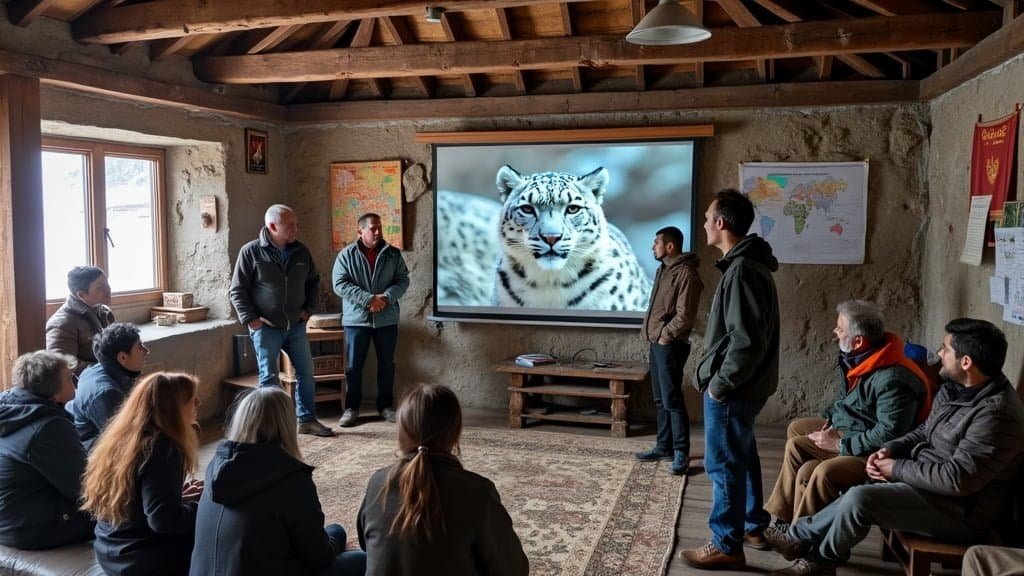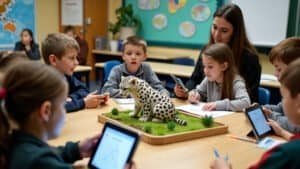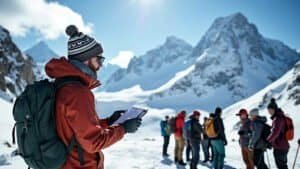Introduction
Conservationists working to protect snow leopards face the challenge of ensuring that their research reaches and resonates with the local communities living in snow leopard habitats
This article explores the various methods used to share research findings, the ways in which local communities are involved in conservation efforts, and the challenges faced in making this information accessible
Additionally, it examines how traditional knowledge is integrated into research and the importance of overcoming barriers like language and geography. Understanding these strategies is crucial for fostering collaboration between scientists and the communities that play a vital role in snow leopard conservation
Methods of Sharing Snow Leopard Research
Conservationists recognize the importance of making their research on snow leopards accessible to local communities, as these communities often live in close proximity to the habitats of these elusive cats
To effectively communicate their findings, conservationists employ a variety of methods tailored to the needs and resources of these communities, ensuring that the information is both understandable and actionable
Use of Visual and Digital Media
Visual and digital media are powerful tools for making complex scientific information more accessible to local communities
Conservationists often create visually engaging presentations, including photos, videos, and infographics, to convey their research findings. These visual aids help bridge language barriers and provide a clear and compelling narrative of the conservation efforts and the status of snow leopards
In some regions, where access to technology is limited, conservationists bring portable digital devices such as tablets or laptops to community meetings, allowing them to share videos and interactive maps that illustrate snow leopard movements and behaviors. In areas with better infrastructure, social media platforms and local radio broadcasts are also used to disseminate information more broadly
Moreover, these visual tools are not just for passive consumption. Workshops often include interactive elements where community members can engage with the data, for example, by exploring maps or participating in games that simulate the challenges snow leopards face. This engagement helps foster a deeper understanding and connection to the conservation goals
Community Workshops and Meetings
Face-to-face interaction remains one of the most effective ways to communicate with local communities. Conservationists organize community workshops and meetings where they present their research findings directly to the residents
These gatherings provide a platform for open dialogue, where community members can ask questions, express concerns, and share their observations
Workshops are often tailored to different audience groups, such as women, elders, or youth, recognizing that each group may have different perspectives and needs
For instance, workshops with elders might focus on integrating traditional knowledge with scientific findings, while those with younger participants might emphasize education and future involvement in conservation efforts
In these meetings, conservationists also seek to build trust by involving local leaders and influencers, who can help convey the importance of the research to the broader community. These leaders often play a crucial role in ensuring that the information is disseminated effectively and that the community feels a sense of ownership over the conservation efforts
Distribution of Educational Materials
In addition to visual and digital presentations, conservationists distribute a range of educational materials that communities can keep and refer to over time. These materials include posters, brochures, and booklets that highlight key aspects of snow leopard ecology, conservation strategies, and the importance of preserving these animals
These educational tools are often designed with input from the community to ensure that they are culturally relevant and accessible
For example, materials may be produced in the local language or dialect and feature imagery and examples that resonate with the community’s daily life and environment. In regions with low literacy rates, materials may include more images and symbols to convey messages effectively
Furthermore, these materials are often left in public spaces such as schools, community centers, or local government offices, where they can reach a wider audience. By providing easily accessible information, conservationists hope to foster ongoing awareness and engagement with snow leopard conservation, even after their direct interaction with the community has ended
Involving Local Communities in Conservation Efforts
Involving local communities in snow leopard conservation efforts is crucial for the long-term success of these initiatives. Conservationists understand that the people who live alongside snow leopards possess invaluable knowledge and experience that can greatly enhance conservation strategies
By engaging these communities as active participants in conservation, rather than merely as observers, conservationists can create more sustainable and effective programs
Participatory Research and Citizen Science
One of the most effective ways to involve local communities is through participatory research and citizen science initiatives
In these programs, community members are trained to assist with data collection, such as monitoring snow leopard populations, tracking movements, and identifying prey species. This approach not only increases the amount of data that can be gathered but also empowers local people by recognizing their role as stewards of their environment
Citizen science programs often involve the use of simple, user-friendly tools, such as GPS devices and camera traps, which community members can operate with minimal training. Conservationists provide hands-on training sessions to ensure that participants are comfortable with the equipment and understand the importance of the data they are collecting
In return, participants gain a deeper understanding of snow leopards and the challenges they face, fostering a sense of ownership and pride in contributing to their protection
This involvement can also lead to more accurate and locally relevant data, as community members bring their unique knowledge of the landscape and wildlife to the project
Training and Capacity Building
Beyond data collection, conservationists focus on building the capacity of local communities to engage in snow leopard conservation. This involves training individuals in a range of skills, from wildlife management and sustainable practices to conflict resolution and leadership
The goal is to equip communities with the knowledge and tools they need to manage their natural resources effectively and to mitigate potential conflicts with snow leopards
Training programs often include workshops on topics such as livestock management techniques that reduce the risk of snow leopard predation, or alternative livelihood options that decrease the community’s reliance on activities that might harm the snow leopard’s habitat. By providing these alternatives, conservationists help reduce the economic pressures that can lead to poaching or habitat destruction
Capacity building also extends to the formation of community-based organizations or committees that take on leadership roles in conservation efforts
These groups are often responsible for monitoring local wildlife, managing community resources, and liaising with conservation organizations. By involving local people in decision-making processes, conservationists ensure that conservation strategies are more likely to be respected and implemented
Collaborative Decision-Making Processes
Effective conservation requires collaboration between scientists, conservationists, and local communities
In many snow leopard habitats, conservationists work closely with community leaders, local governments, and other stakeholders to develop conservation plans that reflect the needs and priorities of the local population
Collaborative decision-making involves holding regular meetings where community members can voice their opinions and contribute to the planning process. These meetings often include discussions on land use, resource management, and conflict mitigation strategies. By ensuring that the community has a say in these decisions, conservationists build trust and encourage greater participation in conservation efforts
In some cases, conservation agreements or pacts are established, outlining the roles and responsibilities of both the conservationists and the community
These agreements may include commitments to protect certain areas, reduce poaching, or participate in monitoring programs. In return, conservationists may provide support in the form of funding, resources, or technical assistance
The success of these collaborative efforts often hinges on the respect for local traditions and the willingness to integrate scientific knowledge with indigenous practices. When communities feel that their knowledge and values are respected, they are more likely to support and actively engage in conservation initiatives
Challenges in Making Research Accessible
Despite the best efforts of conservationists, several challenges arise when attempting to make research on snow leopards accessible to local communities. These challenges often stem from language barriers, geographical isolation, cultural differences, and logistical difficulties
Addressing these challenges is critical to ensuring that research is not only communicated but also understood and applied by the communities living alongside snow leopards
Language Barriers and Solutions
Language is one of the most significant barriers in communicating research findings to local communities. Many snow leopard habitats are located in regions where multiple languages or dialects are spoken, some of which may have little or no written form
Conservationists must navigate these linguistic challenges to ensure that their research is accessible to everyone in the community
To overcome language barriers, conservationists often work with local translators who are fluent in both the scientific language and the local dialects. These translators play a crucial role in accurately conveying complex concepts and ensuring that the community fully understands the information being presented
In addition to translation, conservationists may develop materials in multiple languages or use visual aids that transcend language differences, such as diagrams, illustrations, and videos. These materials are often designed with input from the community to ensure cultural relevance and clarity
Another approach involves using storytelling, a method deeply rooted in many cultures. By framing scientific findings within the context of local myths, legends, or stories, conservationists can make the information more relatable and easier to understand for community members of all ages
Geographic and Logistical Challenges
The remote and rugged terrain where snow leopards live poses significant logistical challenges for conservationists trying to engage local communities. These areas are often difficult to access, with limited infrastructure, making it challenging to reach all members of the community or to hold regular meetings
Conservationists must often travel long distances over difficult terrain to reach isolated communities, sometimes only accessible on foot or by horseback. The lack of reliable transportation and communication networks can also complicate efforts to distribute educational materials or conduct workshops
To address these challenges, conservationists may establish regional hubs or work through local organizations already embedded in the community
These local partners can help disseminate information and coordinate activities, ensuring that even the most remote villages are included in conservation efforts
In some cases, conservationists use mobile units, such as traveling exhibitions or educational vans, to bring information directly to remote communities. These mobile units are equipped with resources such as educational materials, videos, and even portable labs, allowing conservationists to conduct on-site demonstrations and interactive sessions
Addressing Cultural Differences
Cultural differences between conservationists and local communities can also present challenges in making research accessible. These differences can affect how research is perceived, accepted, and applied
For instance, some communities may have traditional beliefs or practices that conflict with modern conservation methods, leading to resistance or misunderstanding
Conservationists must approach these situations with cultural sensitivity and respect. This often involves spending time in the community to build relationships and gain a deeper understanding of local customs and values. By working closely with community leaders and elders, conservationists can learn how best to present their research in a way that aligns with local traditions
One effective strategy is to incorporate traditional ecological knowledge (TEK) into conservation efforts
TEK, which encompasses the understanding and practices developed by indigenous people through generations of interaction with their environment, can provide valuable insights that complement scientific research. By acknowledging and integrating this knowledge, conservationists can bridge cultural gaps and create more holistic and accepted conservation strategies
Moreover, conservationists often engage in cross-cultural training, both for themselves and for community members, to foster mutual understanding and respect. These training sessions can include workshops on cultural awareness, discussions on traditional practices, and opportunities for both sides to share their perspectives on conservation
Integrating Traditional Knowledge in Research
Integrating traditional knowledge into snow leopard conservation research is vital for creating more effective and culturally resonant conservation strategies
Indigenous communities living in snow leopard habitats have accumulated extensive knowledge about the environment, wildlife, and the intricacies of coexisting with these animals over generations
This knowledge, often referred to as Traditional Ecological Knowledge (TEK), can significantly enhance scientific research and conservation efforts when appropriately integrated
Role of Indigenous Knowledge in Snow Leopard Conservation
Indigenous knowledge plays a critical role in understanding the behavior, ecology, and habitat of snow leopards. Local communities have developed detailed knowledge of the landscapes they inhabit, including the seasonal patterns of wildlife, the locations of important resources, and the relationships between different species
This information is often shared orally through stories, songs, and customs, making it essential for conservationists to engage directly with community members to access this valuable insight
For instance, many indigenous communities have a deep understanding of snow leopard prey species and their movements, which can provide crucial information for identifying key habitats and migration corridors. This knowledge can complement scientific data, leading to more accurate and comprehensive conservation strategies
Conservationists often collaborate with local elders, hunters, and herders, who possess a wealth of information on snow leopards and their interactions with the environment
By incorporating this knowledge into their research, conservationists can gain a more nuanced understanding of snow leopard behavior and habitat use, which is essential for effective conservation planning
Case Studies of Successful Collaborations
Several successful collaborations between conservationists and indigenous communities demonstrate the value of integrating traditional knowledge into snow leopard conservation
One notable example is the community-led conservation programs in the Himalayas, where local knowledge has been instrumental in monitoring snow leopard populations and identifying critical habitats
In these programs, community members work alongside scientists to track snow leopards using both traditional methods, such as identifying tracks and signs, and modern technology like camera traps and GPS collars. This combination of traditional and scientific approaches has led to more effective monitoring and a better understanding of snow leopard populations
Another example comes from Mongolia, where the integration of traditional herding practices with modern conservation efforts has helped reduce human-wildlife conflicts
By respecting and incorporating traditional grazing practices, conservationists have been able to work with herders to create grazing plans that minimize the overlap between livestock and snow leopard territories, reducing the risk of predation and retaliation killings
These case studies highlight the importance of mutual respect and collaboration between conservationists and local communities. By valuing and integrating traditional knowledge, conservation efforts become more inclusive, sustainable, and culturally appropriate
Benefits of Blending Scientific and Traditional Approaches
Blending scientific research with traditional knowledge offers numerous benefits for snow leopard conservation. One of the most significant advantages is the creation of more comprehensive and contextually relevant conservation strategies
While scientific research provides data-driven insights into snow leopard populations, genetics, and ecology, traditional knowledge offers a deeper understanding of the local environment, cultural practices, and the human-wildlife relationship
This integrated approach can also lead to greater community buy-in and participation in conservation efforts. When local knowledge is respected and incorporated into conservation plans, communities are more likely to see the value in these efforts and to actively contribute to their success
This collaboration fosters a sense of ownership and responsibility towards snow leopard conservation, which is essential for the long-term sustainability of these initiatives
Moreover, the combination of scientific and traditional knowledge can lead to innovative solutions to conservation challenges. For example, traditional methods of predator deterrence, such as using guard animals or specific herding practices, can be enhanced with modern technology like GPS tracking or predator-proof enclosures
This synergy between old and new methods can improve the effectiveness of conservation measures while maintaining cultural integrity
In summary, the integration of traditional knowledge with scientific research not only enriches the understanding of snow leopards and their habitats but also strengthens the collaboration between conservationists and local communities
This holistic approach is key to ensuring the long-term survival of snow leopards and the preservation of the cultural heritage of the communities that coexist with them
Conclusion
Ensuring that research on snow leopards is accessible to local communities is essential for the success of conservation efforts
Conservationists use a range of methods, from visual media and educational materials to participatory research and traditional knowledge integration, to engage and involve these communities
By overcoming challenges such as language barriers, geographical isolation, and cultural differences, conservationists foster collaboration that enhances both the effectiveness of conservation strategies and the sustainability of local livelihoods
Integrating traditional knowledge with scientific research not only enriches the understanding of snow leopards but also builds trust and ownership among communities, paving the way for more resilient and culturally appropriate conservation practices. Ultimately, the involvement of local communities is not just beneficial but necessary for the long-term protection of snow leopards and their habitats







